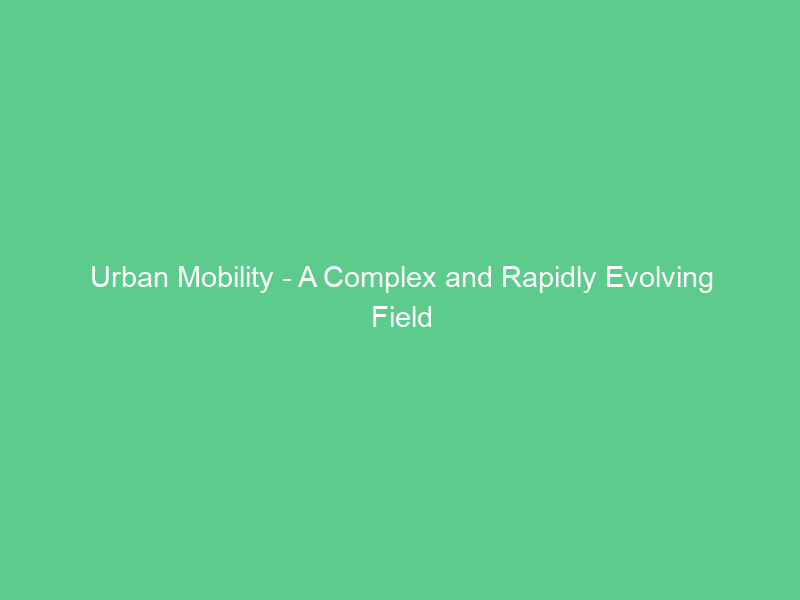
Urban mobility is an ever-evolving field, necessitating new technologies, behavioral nudges and public policies to alleviate traffic congestion and air pollution.
Yet in reality, cities rarely adopt ambitious strategies in their Strategic Urban Mobility Plans (SUMPs). Many European capitals are currently making slow progress toward sustainable transport modes while relying heavily on conventional transport modes.
The Railroad
As soon as railroads were constructed, they provided America with a national transportation network that allowed it to reach far beyond eastern regions and expand rapidly. Their mileage peaked during the second half of the 19th century.
Collective transportation (public transit) refers to large group mobility provided through shared transport modes like tramways, buses, trains and subways operated by public authorities that offer various mobility services designed to meet different mobility needs.
Individual movements are determined by activities like work, leisure and shopping. Movement can vary daily based on activity space; commuting is the most frequent form of travel pattern. Other events, such as major sports tournaments can also influence personal mobility.
The Automobile
The automobile is one of the main contributors to urban mobility in most cities. While its purpose may be economic growth and access to services, its impacts are significant in terms of both environmentalism and socio-ecology.
Traditional solutions to increasing car demand typically include expanding infrastructure for cars, leading to congestion and sprawl. Instead, people-centred urban mobility solutions that prioritize active transport and public transit should be implemented for sustainable cities.
New urban transportation systems can utilize technology to more efficiently utilize resources. Information technologies enable pooled vehicle services for on-demand service models that offer greater flexibility and efficiency than private car journeys; shared robo-shuttles provide mass transit complements while offering an alternative to private journeys.
Suburbanization
Urban mobility refers to traveling within one city and does not encompass intercity transportation. Collective transportation comprises public transit systems operated by agencies and open to the general population at a fee (such as tramways, buses or metro systems).
Suburbanization has long been linked to economic expansion and demographic shifts. But it can also be driven by personal preferences for larger homes with more private exterior space as well as access to better schools or jobs in outlying regions of cities.
Traditional approaches to traffic congestion – expanding car-centric infrastructure – only compound the issue further. Sustainable urban mobility plans must instead prioritize people-centred solutions that focus on active travel and public transit – prioritising safety while shortening journey times for citizens while using new technology to process real time data more efficiently so as to minimize stops and routes.
Multimodal Transport
Multimodal transport refers to the movement of goods using multiple modes of travel – typically rail, road and air transport; it can also include emerging trends such as micro and mini mobility services.
Expanding networks to incorporate more multimodal transport options can help municipalities decrease pollution and emissions while simultaneously improving air quality, pedestrian safety and user experience for drivers as well as users of non-vehicular modes like walking or cycling. Allowing citizens to reach key facilities or destinations without owning a car makes communities more inclusive and economically vibrant by giving non-drivers equal access to low-cost yet equitable forms of transport.
Amazon utilizes air, rail and road transportation in its massive logistics network. Projects designed to improve safety for transit riders, pedestrians and cyclists have also proven beneficial to local business revenue.
MaaS
MaaS (Mobility as a Service) refers to the integration of both public and private mobility services into one app with unified payment channels, allowing users to easily plan, book and pay for complete trips that meet their personal preferences, travel patterns and constraints.
MaaS is designed to promote sustainable mobility and reduce fossil fuel consumption and CO2 emissions. Furthermore, in urban settings it may improve livability by relieving traffic congestion while creating more space for pedestrians and bicycles.
MaaS can boost local economies, as it creates employment in technology, transport management and fleet maintenance fields. Furthermore, it may help organizations attract and retain staff by eliminating company car expenses for staff recruitment purposes.

